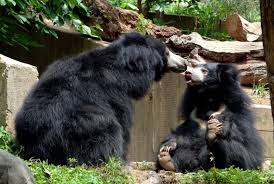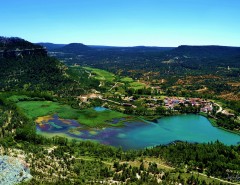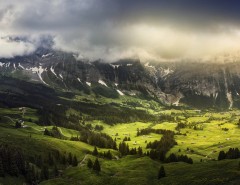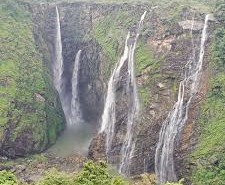Jessore Sloth Bear Sanctuary is situated in the Banaskantha district formerly under Palanpur State in the Indian state of Gujarat at the Gujarat-Rajasthan border. It was declared as a sanctuary in May 1978, covering an area of about 180 square kilometres (69 sq mile), principally for protection of the sloth bear, which is now categorized as “Vulnerable A2cd+4cd;C1 ver 3.1” on the IUCN Red List. Their numbers are declining in the wild and they are threatened with extinction.
The name “sloth” is said to be the epithet travellers and hunters in India gave to the bear when they saw it hanging upside down from branches of trees and consequently they identified it with sloth, an animal that hangs upside down. While it is now known as sloth bear, initially it was called “bear sloth” since the game hunters identified this species with the sloth of South America as the physical characteristics and arboreal habits of both species matched. Towards the later part of the 18th century, its scientific name was Ursine bradypus, Ursiform sloth or Bradypus ursinus. But when in the early 19th century, a sloth bear, housed in a zoo in France, was examined, scientists identified it correctly as a bear species and thereafter the name was changed from “bear sloth” to “sloth bear”. Jessore hill, which is the back drop to the sanctuary, is also prefixed to form the full name “Jessore Sloth Bear Sanctuary”.
Ministry of Environment and Forests of the Government of India, Forest Department of Gujarat, well known Institutes and Universities of the country, stakeholders and local communities in and around the project area have been engaged in Conservation and Sustainable Management of Dryland Biodiversity of North Gujarat under a GEF/UNDP supported project with the objective of conservation of globally significant biodiversity. The two projects identified under the programme, as demonstration project sites were the Jessore and Balaram-Ambaji Sanctuaries. The information gathered under this project in respect of the Jessore Sloth Bear Sanctuary has enhanced the information base and is expected to help in building local establishments to adopt novel ideas to resolve the threats faced by the sanctuary.
Geography
The sanctuary is located in the Jessore hills of Aravalli hills, to the south of the Thar desert. It was declared a sanctuary covering an area of 180.66 square kilometres (69.75 sq mile) in 1978. The sanctuary area lies between the desert ecosystem and the dry deciduous type of ecosystem, and the forested area helps in arresting desertification and advancement of Thar desert.
The nearest airport is Ahmedabad is 190 kilometres (120 mile) away. Nearest Railway station is at Palanpur, 45 kilometres (28 mile) away and Iqbalgarh village is at 8 kilometres (5.0 mile) distance.[citation needed] The Sanctuary also houses two temples (one of them is the Kedarnath Mahadev temple), which are frequented by a large number of pilgrims during October–November, and a protected sacred grove.
Flora and fauna
Flora
The vegetation in the sanctuary consists of arid to semiarid and dry deciduous thorny scrub.
A UNDP sponsored study of the flora of the sanctuary has identified 406 species of plants (90 trees, 47 shrubs, 33 climbers, 194 herbs, 31 grasses, six pteridophytes, two bryophytes, one epiphyte, and two fungi). A further analysis indicates that the families of tree species are 13, shrubs 15, herbs 11 and climbers 13. Some of the species reportedly belong to the threatened category as per IUCN; these are: Pavonia arabica, Tecomella undulata, Capparis cartilaginea, Dendrocalamus strictus, Sterculia urens and silver date palm and Ceropegia odorata, an endangered species. Six endemic species to India recorded are Ogeissus sericea, Chlorophytum borivilianum, Sterculia urens, Tecomella undulata, silver date palm and Dendrocalamus strictus. Further, 89 plants are recorded to have medicinal properties.
However, forest area is reportedly diminishing, and the corridor with hill area forests of Aravalli is also reducing, disrupting the migration of the bears. As a result, forest areas are reported only in patches. Prosopis juliflora called locally as gando baval has become the dominant vegetation affecting spread of local species, growth of goat and cattle population and forest fires; about 40 per cent of the green cover in the lower areas and 20 per cent in hilly regions are covered by this weed.
Fauna
Apart from sloth bear, other fauna reported in the sanctuary are leopard, sambar, blue bull, wild boar, porcupine, and a variety of birds.[citation needed] Other endangered species harboured by the sanctuary are jungle cat, civet, caracal, wolf and hyena.
The faunal study by UNDP covered the herpetofaunal group. 14 species of amphibians and reptiles have been recorded here; the list includes Indian python (Python molurus) an endangered species, Indian flap-shelled turtle (Lissemys punctata) of vulnerable category and muggar (Crocodylus palustris) and Varanus (Varanus bengalensis) of endangered category. Threats faced by these species have been noted as water shortage, traffic, and hunting by snake charmers.
Reptiles found also include cobra, krait, several types of viper and monitor lizard.
Avifauna
Studies of avifauna in the sanctuary revealed 105 species, including migratory birds. The list includes: four near threatened category birds comprising grey jungle fowl (Gallus sonneratii), white-bellied minivet (Pericrocotus erythropygus), Indian black ibis (Pseudibis papillosa) and painted stork (Mycturia leucocephala); the vulnerable category (as per IUCN Red List) are white-winged black tit (Parus nuchalis), Asian openbill (Anastomus oscitans), Indian white-rumped vulture (Gyps Bengalensis), Indian vulture (Gyps indicus), red-headed vulture (Sarcogyps calvus) and red-necked falcon (Falco chicquera).
Mammalian fauna
20 species of mammalian fauna have been identified. Of these Indian pangolin (Manis crassicaudata) and sloth bear (Melursus ursinus) are near threatened and vulnerable respectively.
Sloth bear
Left: common sloth bear (Melursus ursinus ursinus) in India. Right: Sri Lankan sloth bear (Melursus ursinus inornatus)
Sloth bear is an animal found in many parts of Asia including Nepal, Sri Lanka, Bhutan and Bangladesh. Two subspecies have been recognized namely, the Indian sloth bear (Melursus ursinus ursinus) and the Sri Lankan sloth bear (Melursus ursinus inornatus).
Sloth bear is omnivorous, black and dark brown in colour with an yellowish patch on the chest, has large feet and claws, as tall as 5–6 feet (1.5–1.8 m), heavy in size (males weigh 175–310 pounds (79–141 kg), females 120–210 pounds (54–95 kg)), runs as fast as humans and has a long muzzle. Their habitats can be dry forest or wet rain forest or grass lands with shrubs trees and stones. They eat insects, their favourite is termites, live on fruits (mangoes and figs), grass and honey. Fifty percent of their diet is fruits during March to June, and termites and other insects the rest of the time. They have high sensory perception. It is the only bear with long hair on the ears. Its life span is estimated as 25 years.
- Country – India
- State – Gujarat
- District – Banaskantha
- Nearest city – Palanpur
- Area – 180.66 km2
- Established – May 1978




